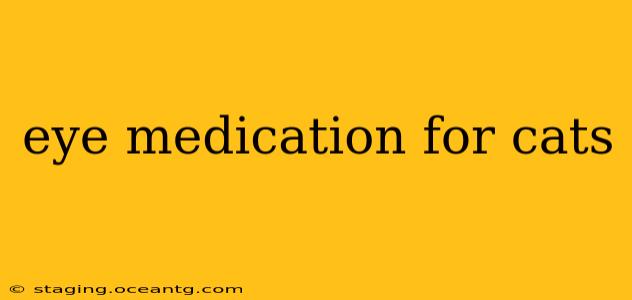Cats, with their captivating eyes, are prone to various eye conditions requiring medication. Understanding the types of eye medications available, how to administer them, and when to seek veterinary care is crucial for responsible cat ownership. This comprehensive guide will address common questions and concerns surrounding feline eye medication.
What are the common eye problems in cats that require medication?
Cats can suffer from a range of eye issues, many of which necessitate medication for effective treatment. These include:
- Conjunctivitis (Pink Eye): Inflammation of the conjunctiva, the membrane lining the eyelids and covering the white part of the eye. This can be caused by allergies, infections (bacterial or viral), or irritants.
- Keratitis: Inflammation of the cornea, the transparent front part of the eye. This can lead to pain, blurred vision, and even corneal ulcers if left untreated.
- Glaucoma: Increased pressure within the eye, which can damage the optic nerve and lead to blindness.
- Cataracts: Clouding of the eye's lens, impairing vision.
- Uveitis: Inflammation of the uvea, the middle layer of the eye. This can be caused by infections, injuries, or autoimmune diseases.
- Eye Infections (Bacterial or Viral): Various bacteria and viruses can infect the eyes, causing discharge, redness, and discomfort.
The specific medication prescribed will depend entirely on the underlying cause and severity of the eye condition. Always consult your veterinarian for diagnosis and treatment.
What types of eye medications are used for cats?
Veterinarians may prescribe several types of eye medications for cats, including:
- Antibiotics: These combat bacterial infections, often in the form of ointments or drops.
- Antivirals: Used to treat viral infections of the eye.
- Anti-inflammatory drugs: Reduce inflammation and pain, often used in conditions like conjunctivitis and uveitis. These may be steroids or non-steroidal anti-inflammatory drugs (NSAIDs).
- Pain relievers: Manage pain associated with eye conditions, especially those involving corneal ulcers or glaucoma.
- Mydriatics: Dilate the pupils, allowing for better examination of the eye's interior. Often used during eye exams.
The formulation (ointment or drops) and frequency of administration will be determined by your veterinarian based on your cat's specific needs.
How do I administer eye medication to my cat?
Administering eye medication to a cat can be challenging. Here's how to approach it:
- Prepare the medication: Gently shake the bottle (if applicable) and have a clean tissue or cotton ball ready.
- Restrain your cat: Have someone assist you in gently restraining your cat, holding them securely but comfortably. A towel can be helpful.
- Clean the eye: Gently wipe away any discharge from the eye using a clean, damp cotton ball.
- Apply the medication: Hold the dropper or tube close to the eye, but don't touch the eye itself. Gently squeeze a small amount of medication into the lower eyelid pocket (the conjunctival sac).
- Massage gently: Gently massage the area around the eye to help distribute the medication.
- Reward your cat: Offer praise and a treat to make the experience more positive.
If you are struggling to administer the medication, consult your veterinarian for assistance or consider asking a veterinary technician for guidance. They can demonstrate the correct technique and help you build your confidence.
Can I use human eye drops on my cat?
No. Never use human eye drops on your cat. Human eye medications are formulated for human eyes and may contain ingredients toxic to cats. Always use medications specifically prescribed by your veterinarian for your cat's condition.
How long does it take for eye medication to work in cats?
The time it takes for eye medication to show improvement varies depending on the type of medication, the severity of the condition, and your cat's individual response. Some conditions may improve within a few days, while others may require longer-term treatment. Always follow your veterinarian's instructions carefully and attend all follow-up appointments.
When should I call my veterinarian about my cat's eye?
Contact your veterinarian immediately if you notice any of the following:
- Sudden changes in vision: Squinting, bumping into objects.
- Excessive tearing or discharge: Especially if it's cloudy, yellow, or green.
- Redness, swelling, or pain in the eye.
- Cloudiness of the cornea or lens.
- Third eyelid protrusion.
- Any significant changes in your cat's behavior or appetite.
Early intervention is key to successful treatment of feline eye problems. Don't hesitate to contact your veterinarian if you have any concerns about your cat's eye health. Regular veterinary check-ups are also essential for maintaining your cat's overall well-being, including their eye health.
